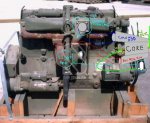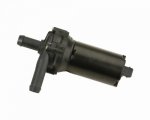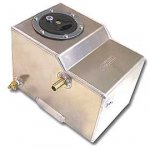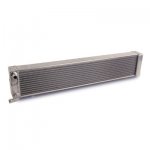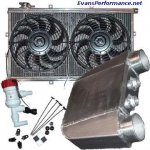merlot566jka
Member
- 360
- 0
- 16
- Location
- ID or TX or OK
I am probably going to buy a water to air intercooler and add it to my deuce in the next month. I have some training in sea going and industrial diesels, and they call them after coolers and charge air coolers. Whatever you may call them, I want one!
I was looking at civy trucks to see if anyone has a setup like that. I found on a couple cummins/duramax forums people have tried the popular chinese made water to air coolers that can be bought online. Thier results were most impressive! As were most turbo gasoline cars I have seen results posted for.
So as you would expect, the bigger the intercooler core, the bigger the radiator; the cooler your post turbo air charge. But the advantage here, over what a normal air to air intercooler has, is that there is virtually no pressure loss due to the cooler.
My plans are to try out the cheap water to air intercoolers I can buy online. I will buy one that is larger than the capacity of our engine. I will post test results measuring EGT, Boost PSI, and Intake temp. As of now, I am at 1100* EGT and 11psi boost at wot up a steep grade. I will turn up the fuel once the EGT goes down.
The goals:
Decrease EGT
Increase Power
Increase MPG
Do something fun
I will post a total cost analysis... but I can tell you already it would take almost 9000 miles of driving if this improved 1mpg to pay for itself....
For those of you who have no idea what I am talking about, I will try to explain.
Air to water intercooler uses a core similar to a heater core. On the wet side of the core, water is plumbed through. On the dry side, your turbos compressed air, that is really hot, is pushed through the core. As the air moves over and about the core, the water inside removes the heat through thermal heat transfer and conduction. The turbo compressed air is now cooler and more dense, which meants it can burn more fuel. The hot water from the wet side of the core is now pumped into what is essientially a radiator and is cooled to ambient or lower temprature. Then that cold water is pumped back through the same loop, cooling the charge air. And so on.
Some facts:
The radiator is often smaller than a normal car radiator.
The fluid capacity is usually about 2-4 gallons.
The pump is often a bilge pump, or Bosch cobra (ford)
Some use ice water for drag racing and use no radiator.
The core is much smaller than what a normal air to air intercooler core is.
The core flows air much better than you would think, there is virtually no loss.
I was looking at civy trucks to see if anyone has a setup like that. I found on a couple cummins/duramax forums people have tried the popular chinese made water to air coolers that can be bought online. Thier results were most impressive! As were most turbo gasoline cars I have seen results posted for.
So as you would expect, the bigger the intercooler core, the bigger the radiator; the cooler your post turbo air charge. But the advantage here, over what a normal air to air intercooler has, is that there is virtually no pressure loss due to the cooler.
My plans are to try out the cheap water to air intercoolers I can buy online. I will buy one that is larger than the capacity of our engine. I will post test results measuring EGT, Boost PSI, and Intake temp. As of now, I am at 1100* EGT and 11psi boost at wot up a steep grade. I will turn up the fuel once the EGT goes down.
The goals:
Decrease EGT
Increase Power
Increase MPG
Do something fun
I will post a total cost analysis... but I can tell you already it would take almost 9000 miles of driving if this improved 1mpg to pay for itself....
For those of you who have no idea what I am talking about, I will try to explain.
Air to water intercooler uses a core similar to a heater core. On the wet side of the core, water is plumbed through. On the dry side, your turbos compressed air, that is really hot, is pushed through the core. As the air moves over and about the core, the water inside removes the heat through thermal heat transfer and conduction. The turbo compressed air is now cooler and more dense, which meants it can burn more fuel. The hot water from the wet side of the core is now pumped into what is essientially a radiator and is cooled to ambient or lower temprature. Then that cold water is pumped back through the same loop, cooling the charge air. And so on.
Some facts:
The radiator is often smaller than a normal car radiator.
The fluid capacity is usually about 2-4 gallons.
The pump is often a bilge pump, or Bosch cobra (ford)
Some use ice water for drag racing and use no radiator.
The core is much smaller than what a normal air to air intercooler core is.
The core flows air much better than you would think, there is virtually no loss.


